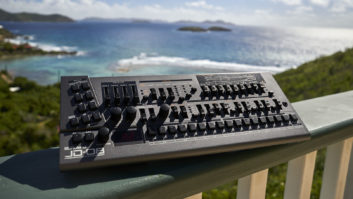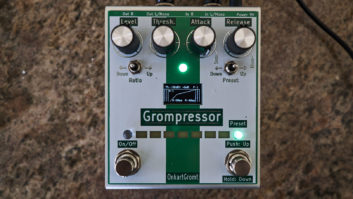Mixer Dave Way is standing in front of an SSL 9000E listening to the mix he finished the night before. Next to him, producer Walter Afanasieff is bopping along in his chair, grooving to the song. Behind them, Savage Garden singer Darren Hayes is listening intently, but looking a bit depressed. A couple of minutes later, in the lounge of Afanasieff’s Wally World studio in San Rafael, Calif., he quietly admits, “I couldn’t finish the vocals on this song; it took me almost a week. I think I was drawing it out because I love being here so much.”
Half a world away, in the their native Australia, the musical brains behind Savage Garden, Daniel Jones, echoes his partner’s fondness for Wally World. “It was one of the best environments I’ve ever been in to record or to write music,” he says. “It was so relaxed.”
The team of Savage Garden and Afanasieff first joined forces when the lads recorded “Animal Song” for the soundtrack to The Other Sister, but Afanasieff admits he was a bit surprised they wanted to work with him in the first place. “After the initial surprise of them wanting to work with me, I sort of took what I do and what they do and mashed it together,” he says. “That’s what we’ve been doing.” Part of what Afanasieff brought to the table was a heavier sound, which he says was what the band was looking for. “They thought that their first album was a little too light, a little too thin-sounding. I just wanted to add thickness and girth without taking away from their songwriting and their sound. They definitely have a very unique, very particular songwriting style, and if you write a song like they do, you can’t really change so much of it.”
Savage Garden had made their first album themselves, but they turned to Afanasieff for help on about four of the 12 songs found on Affirmation. According to Jones, they take their demos to near-completion for one simple reason: “We just want to make sure there was that Savage Garden element before we went in to hand these songs over to a third party. We didn’t want to be taken away from where we started and come from. We wanted to make sure we had our sound in the demos at the early point, so it would hopefully continue through to the finished album, which it did quite well.”
Indeed, Afanasieff was sensitive to the fact that their songwriting process includes polished demos. “I took the songs and I simply put it into a full-scale production process in the studio,” he says. “So it doesn’t matter if Daniel already had a drum sequence on his demo or there was a keyboard part sequence or there was a bass line going. To me, that’s the essence of the song and how they wrote the song, and all I do is take it a step further.”
Though he doesn’t have any particular keyboard favorites, Jones found himself turning to a Korg Trinity to write, as well as Roland’s S-760 sampler and its libraries. He also recorded some tracks into a Roland VS-1680 digital workstation. Rather than having to bring a ton of keyboards and other instruments into Wally World, however, Jones merely brought a half-dozen Zip disks, a couple of DATs for referencing demos, and the guitar tracks on the VS-1680 disks. He brought the VS-1680’s CD burner as well, because he heard there wasn’t one to be found in the States.
If that were true, the CD burner would have been the only electronic bit of gear that wasn’t actually at Wally World when the band walked in to start working. With a laugh, Afanasieff admits, “I kind of wanted to show off before they got here, so I went and literally got everything new and even some things that were prototypes and things they were beta testing. I wanted to kick their butts when they got here with everything that I had. When they walked in, it was like, we have anything and everything you could possibly want, from the old to the most new. I mean there’s a hundred boxes that we bought just to have Savage Garden go, ‘Oooo, what’s that?'”
“You plugged it in and it wasn’t connected or anything, so you could tell it was acting like a prop rather than an instrument,” Jones laughs. “It was just there to impress us, I think. But we finally made use of most of it. It was great.”
A number of Jones’ original files were re-recorded at Wally World, some with live players. Afanasieff explains that by playing on some of the tracks himself and using drummer Steve Smith, bassist Nathan East, and session guitarists Michael Landau, Michael Thompson and Dean Parks, he was trying to lighten Jones’ load. “The reason I’m playing keyboards is because he didn’t want to leave it all up to himself to do that,” Afanasieff says. “The same thing applied to guitars-he did what he wanted to do on his guitar part, but we thought that there’s a little bit more to do. Rather than have him think of it all and try it all and get equipment to cover it all and different amps and guitars and parts and stuff like that, we just opted to get help.” The vocal duties, on the other hand, were pure Hayes. They may have doubled and quadrupled some parts, but everything from the lead to the backgrounds were done by him.
No matter what instrument the team was recording, the goal was to stay in the digital domain throughout, which they accomplished right up to the mix phase when they dumped everything down to a pair of Sony PCM-3348HRs. For the recording dates they used a combination of ProTools|24 and a Fairlight MFX-3plus (a hometown nod for the Australian-based band). The Fairlight came into play while they tracked vocals, piano and acoustic guitar. “Fairlight to me is probably the best piece of recording equipment for those instruments,” Jones says. Though it has some of the same ingredients as a lot of other digital recorders, Jones says it is the unit’s playback quality that impressed him. “It just seemed to have much more of a high definition,” he notes. “It was a little warmer than the average digital recording. It was just overall a much clearer, better sound for those instruments.”
Pro Tools came in handy while they were tracking electric guitars and building sequences with Logic Audio. Line 6’s Amp Farm was used for the guitar dates, and Lo-Fi was used on some loops. That’s not to say that was the only way they effected the signal. “I think everyone was more of a fan in using outboard gear or trying to find the right sound to begin with that had some sort of effect to it, rather than trying to reproduce something that wasn’t there through a plug-in,” he explains. “Especially delays. We used outboard delays a hell of a lot.” The trade-off is that all this technology burns tracks-up to 96 on a few songs.
For Afanasieff, working with Savage Garden was a nice stylistic departure from his usual fare-after all, this is the producer who has worked with Whitney, Mariah, and was completing a Kenny G album in the middle of the Savage Garden project. “You don’t make a Kenny G record like this. Nothing against Kenny, but you just don’t make records like this where you sit around and say, ‘Oh, man, let’s come up with something that doesn’t sound like anything you’ve ever heard before.’ And then do it again and again and then do 80 tracks of stuff like that,” Afanasieff says. “Then it all gets covered up by rock guitars, but you know that underneath those rock guitars there are 80 tracks of digitized, Pro Tools-looped, sliced up, cut up, Logic-ed up, total filter-sweetened sounds.”
The man responsible for smoothing those stacked sounds was Way, who gushes over the music. “There was not one song on here that I didn’t care for or didn’t get excited about when I was mixing it,” he says in the control room. “Every song was like, ‘Wow, we can do this on this.’ The vocal performances are great on every song, there’s cool guitar parts and amazing keyboards and drum programming and sounds.”
Although the plethora of tracks occasionally became a problem, Way reports that “within an hour I would usually have a basic balance that I thought was the general shape, because a lot of these sounds from the keyboards in particular, and the guitars, are printed with these great effects on them, and it gives you all this versatility to use that or develop on top of that,” he says. He adds that the number of tracks is a bit deceiving because there are many drum and keyboard parts that were recorded in stereo. Outboard gear that Way used on the mix included the DSP 4000, dbx 165s, Avalon EQs and the TC Electronic FireworX reverb package.
While Hayes, Afanasieff and Way finish the last mixes, instrumentalist Jones is back in Australia working with a touring band. Looking back, he can see how important it was for the group to work with Afanasieff. “We would constantly play around until something was right. Walter had the patience of a god, he was so patient,” Jones says. “He was so into the project and didn’t want to settle for anything less, which lifted our standards up quite a lot. Darren and I are pretty quick to say, ‘Yeah, that’ll do. We’ll throw that down.’ But when we came to work with Walter, he said, ‘Are you sure that will do? Do you think we can find something better for that?’ So, he was the perfect producer and he would challenge us just to go to that next level to find something that would work that little bit more.”
And as Afanasieff and Way are hunched over the console, looking for that “thing” to make the song better, Hayes smiles and shrugs his shoulders. “Listen, I don’t want to go backstage at the magic show,” he says with a smile. “I just want you to make magic.”







